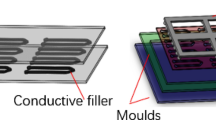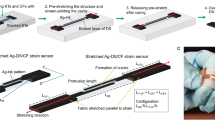Abstract
The softness and stretchability of soft sensors has generated much interest with respect to applying soft sensors for human activity monitoring and proprioception of soft robots. However, most of the research in this area has focused on electrical stability, despite the importance of mechanical failure, thus limiting practical application. In this study, the lifetime of silicone-based soft sensors was examined under accelerated cyclic strain conditions, to construct lifetime prediction models of crack nucleation and growth considering the failure properties of the sensor’s silicone elastomer. To establish the models, an accelerated life test was conducted, in which the lifetime was estimated according to a Weibull distribution under accelerated cyclic strain conditions. Specifically, a lifetime prediction model using the crack growth approach (CGA) was constructed by experimentally measuring the energy release rate (tearing energy) of the silicone elastomer due to crack propagation. Compared to the inverse power law-based model, the CGA-based model showed about 90% improvement in lifetime prediction accuracy in the strain ranges from 150 to 270% with root mean square error 456 and 4592 cycles, respectively, thus indicating that tearing energy is an important parameter for sensor lifetime prediction. The proposed model is expected to be useful for predicting the lifetime of soft sensors under various strain operating conditions.








Similar content being viewed by others
References
Tabatabai, A., Fassler, A., Usiak, C., & Majidi, C. (2013). Liquid-phase gallium–indium alloy electronics with microcontact printing. Langmuir, 29(20), 6194–6200.
Sun, J. Y., Keplinger, C., Whitesides, G. M., & Suo, Z. (2014). Ionic skin. Advanced Materials, 26(45), 7608–7614.
Roh, E., Hwang, B. U., Kim, D., Kim, B. Y., & Lee, N. E. (2015). Stretchable, transparent, ultrasensitive, and patchable strain sensor for human–machine interfaces comprising a nanohybrid of carbon nanotubes and conductive elastomers. ACS Nano, 9(6), 6252–6261.
Gong, S., Schwalb, W., Wang, Y., Chen, Y., Tang, Y., Si, J., & Cheng, W. (2014). A wearable and highly sensitive pressure sensor with ultrathin gold nanowires. Nature Communications, 5(1), 1–8.
Atalay, O., Atalay, A., Gafford, J., & Walsh, C. (2018). A highly sensitive capacitive-based soft pressure sensor based on a conductive fabric and a microporous dielectric layer. Advanced Materials Technologies, 3(1), 1700237.
Xu, P. A., Mishra, A. K., Bai, H., Aubin, C. A., Zullo, L., & Shepherd, R. F. (2019). Optical lace for synthetic afferent neural networks. Science Robotics, 4(34), eaaw6304.
Spells, K. E. (1936). The determination of the viscosity of liquid gallium over an extended n range of temperature. Proceedings of the Physical Society (1926–1948), 48(2), 299.
Dickey, M. D., Chiechi, R. C., Larsen, R. J., Weiss, E. A., Weitz, D. A., & Whitesides, G. M. (2008). Eutectic gallium-indium (EGaIn): A liquid metal alloy for the formation of stable structures in microchannels at room temperature. Advanced Functional Materials, 18(7), 1097–1104.
Boley, J. W., White, E. L., Chiu, G. T. C., & Kramer, R. K. (2014). Direct writing of gallium–indium alloy for stretchable electronics. Advanced Functional Materials, 24(23), 3501–3507.
Kim, S., Oh, J., Jeong, D., Park, W., & Bae, J. (2018). Consistent and reproducible direct ink writing of eutectic gallium–indium for high-quality soft sensors. Soft Robotics, 5(5), 601–612.
Kim, S., Oh, J., Jeong, D., & Bae, J. (2019). Direct wiring of eutectic gallium–indium to a metal electrode for soft sensor systems. ACS Applied Materials Interfaces, 11(22), 20557–20565.
Park, W., Ro, K., Kim, S., & Bae, J. (2017). A soft sensor-based three-dimensional (3-D) finger motion measurement system. Sensors, 17(2), 420.
Kim, D., Kwon, J., Han, S., Park, Y. L., & Jo, S. (2018). Deep full-body motion network for a soft wearable motion sensing suit. IEEE/ASME Transactions on Mechatronics, 24(1), 56–66.
Thuruthel, T. G., Shih, B., Laschi, C., & Tolley, M. T. (2019). Soft robot perception using embedded soft sensors and recurrent neural networks. Science Robotics, 4(26), eaav1488.
Wirekoh, J., Valle, L., Pol, N., & Park, Y. L. (2019). Sensorized, flat, pneumatic artificial muscle embedded with biomimetic microfluidic sensors for proprioceptive feedback. Soft Robotics, 6(6), 768–777.
Park, W., Seo, S., Oh, J., & Bae, J. (2020). A sensorized hybrid gripper to evaluate a grasping quality based on a largest minimum wrench. IEEE Robotics and Automation Letters, 5(2), 3243–3250.
Liu, S., Shah, D. S., & Kramer-Bottiglio, R. (2021). Highly stretchable multilayer electronic circuits using biphasic gallium-indium. Nature Materials, 20(6), 851–858.
Xu, S., Vogt, D. M., Hsu, W. H., Osborne, J., Walsh, T., Foster, J. R., & Wood, R. J. (2019). Biocompatible soft fluidic strain and force sensors for wearable devices. Advanced Functional Materials, 29(7), 1807058.
Chen, J., Zhang, J., Luo, Z., Zhang, J., Li, L., Su, Y., & Li, H. (2020). Superelastic, sensitive, and low hysteresis flexible strain sensor based on wave-patterned liquid metal for human activity monitoring. ACS Applied Materials Interfaces, 12(19), 22200–22211.
Mengüç, Y., Park, Y. L., Pei, H., Vogt, D., Aubin, P. M., & Winchell, E. (2014). Wearable soft sensing suit for human gait measurement. The International Journal of Robotics Research, 33(14), 1748–1764.
Xavier, M. S., Tawk, C. D., Zolfagharian, A., Pinskier, J., Howard, D., Young, T., ... & Fleming, A. J. (2022). Soft pneumatic actuators: A review of design, fabrication, modeling, sensing, control and applications. IEEE Access.
Yarali, E., Baniasadi, M., Zolfagharian, A., Chavoshi, M., Arefi, F., Hossain, M., & Bodaghi, M. (2022). Magneto-/electro-responsive polymers toward manufacturing, characterization, and biomedical/soft robotic applications. Applied Materials Today, 26, 101306.
Case, J. C., White, E. L., & Kramer, R. K. (2015). Soft material characterization for robotic applications. Soft Robotics, 2(2), 80–87.
Mars, W. V., & Fatemi, A. (2002). A literature survey on fatigue analysis approaches for rubber. International Journal of fatigue, 24(9), 949–961.
Miron, G., & Plante, J. S. (2016). Design principles for improved fatigue life of high-strain pneumatic artificial muscles. Soft Robotics, 3(4), 177–185.
Mars, W. V., & Fatemi, A. (2003). Fatigue crack nucleation and growth in filled natural rubber. Fatigue and Fracture of Engineering Materials and Structures, 26(9), 779–789.
ASTM D4482–11. (2021). Standard test method for rubber property—Extension cycling fatigue. West Conshohocken, PA: ASTM International.
Rivlin, R. S., & Thomas, A. G. (1953). Rupture of rubber. I. Characteristic energy for tearing. Journal of Polymer Science, 10(3), 291–318.
Lake, G. J., & Lindley, P. B. (1965). The mechanical fatigue limit for rubber. Journal of Applied Polymer Science, 9(4), 1233–1251.
Lake, G. J. (1995). Fatigue and fracture of elastomers. Rubber Chemistry and Technology, 68(3), 435–460.
ASTM D412–16. (2021). Standard test methods for vulcanized rubber and thermoplastic elastomers—tension. West Conshohocken, PA: ASTM International.
Smooth-On. (2021). Dragon Skin 30. https://www.smooth-on.com
Jeong, U., Kim, K., Kim, S. H., Choi, H., Youn, B. D., & Cho, K. J. (2021). Reliability analysis of a tendon-driven actuation for soft robots. The International Journal of Robotics Research, 40(1), 494–511.
Hu, C., Youn, B. D., & Wang, P. (2019). Engineering design under uncertainty and health prognostics (pp. 1–100). Springer.
Kim, D. W., Oh, H., Youn, B. D., & Kwon, D. (2016). Bivariate lifetime model for organic light-emitting diodes. IEEE Transactions on Industrial Electronics, 64(3), 2325–2334.
El Yaagoubi, M., Juhre, D., Meier, J., Kröger, N., Alshuth, T., & Giese, U. (2018). Lifetime prediction of filled elastomers based on particle distribution and the J-integral evaluation. International Journal of Fatigue, 112, 341–354.
Yang, Z., & Lin, D. K. (2007). Improved maximum-likelihood estimation for the common shape parameter of several Weibull populations. Applied Stochastic Models in Business and Industry, 23(5), 373–383.
Lindley, P. B. (1972). Energy for crack growth in model rubber components. Journal of Strain Analysis, 7(2), 132–140.
Klemenc, J., Seruga, D., & Nagode, M. (2019). A durability prediction for the magnesium alloy AZ31 based on plastic and total energy. Metals, 9(9), 973.
Gehrmann, O., Kröger, N. H., Krause, M., & Juhre, D. (2019). Dissipated energy density as fatigue criterion for non-relaxing tensional loadings of non-crystallizing elastomers? Polymer Testing, 78, 105953.
Yeoh, O. H. (1993). Some forms of the strain energy function for rubber. Rubber Chemistry and technology, 66(5), 754–771.
Wilks, S. S. (1938). The large-sample distribution of the likelihood ratio for testing composite hypotheses. The Annals of Mathematical Statistics, 9(1), 60–62.
ASTM D624-00. (2020). Standard test method for tear strength of conventional vulcanized rubber and thermoplastic elastomers. West Conshohocken, PA: ASTM International.
Acknowledgements
This work was supported by the National Research Foundation of Korea (NRF) grant funded by the Korean Government (MSIT) (No. NRF-2019R1A2C2084677 and NRF-2016R1A5A1938472), and Korea Evaluation Institute of Industrial Technology (KEIT) grant funded by the Korea Government (No. 20008912).
Author information
Authors and Affiliations
Corresponding author
Ethics declarations
Conflict of interest
All authors declare that they have no conflict of interest.
Additional information
Publisher's Note
Springer Nature remains neutral with regard to jurisdictional claims in published maps and institutional affiliations.
Rights and permissions
Springer Nature or its licensor holds exclusive rights to this article under a publishing agreement with the author(s) or other rightsholder(s); author self-archiving of the accepted manuscript version of this article is solely governed by the terms of such publishing agreement and applicable law.
About this article
Cite this article
Kim, K., Bae, J. Lifetime Prediction of Silicone and Direct Ink Writing-Based Soft Sensors Under Cyclic Strain. Int. J. of Precis. Eng. and Manuf.-Green Tech. 10, 535–546 (2023). https://doi.org/10.1007/s40684-022-00469-1
Received:
Revised:
Accepted:
Published:
Issue Date:
DOI: https://doi.org/10.1007/s40684-022-00469-1




